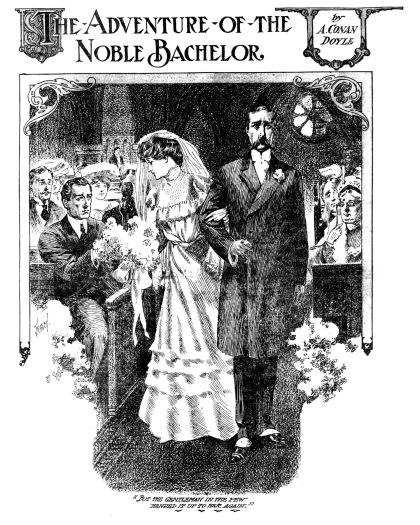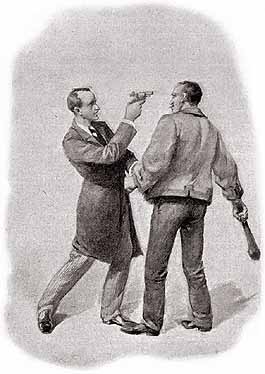Sherlock Sunday: Bacherlor & Beryl
Mar. 9th, 2025 04:38 pm"The Case of the Noble Bachelor" was published in the UK in April 1892.
In this case, Lord Robert St Simon visits Sherlock Holmes because his fiancée, Miss Hatty Doran, disappeared on the day of their wedding.
So it turns out Hatty's first husband (thought dead) pops up at the wedding, and she runs away with him. And Holmes thinks it would be a great idea to invite everyone to supper (the happy reunited couple, Watson, and the Noble Bachelor of the title, Lord Robert St. Simon, who loses his rich American heiress.). That seems a bit mad, to be honest.
Did Hatty commit bigamy by not stopping the service and making a scene at the church (when she sees her thought-dead first husband)? She did marry another man while being aware (by minutes) that her husband was still alive.

"The Adventure of the Beryl Coronet"
In this case, the banker Alexander Holder goes to Baker Street to tell Holmes his story: he lent £50,000 to a client (thought to be the Prince of Wales) who gave him as collateral the famous beryl coronet. Of course, the coronet is stolen, mangled and three of the stones lost.
Beryls are stones which, when colored, are gems. Green beryls are emeralds. Blue-green beryls are aquamarines. The story doesn't tell us what color these beryls are.
Holmes determines that it was the banker's niece and not his son who is responsible for the theft, aided by an unscrupulous older lover Sir George Burnwell.
I said during Sherlock 60 that I think the relationship between uncle and niece is a bit fishy and the fact that she escapes with a disreputable older man confirms my suspicions.
I am using The New Annotated Sherlock Holmes edited by Leslie Klinger and there is a note by one critic that whenever Holmes has occasion to pull a gun, he gets as near as possible to the person, this critic claimes, owing to poor marksmanship. And in this story he does 'clap a pistol to Burnwell's head.'
Also, they say that even damage to the coronet would be bad and it is damaged, twisted and stones broken off, but the banker runs off at the end to make amends with his son whom he had falsely accused instead of to a goldsmith to get the thing repaired by Monday when the Prince of Wales wants it back. But could the Prince of Wales pawn a public item, national treasure such as that? Hmm.

In this case, Lord Robert St Simon visits Sherlock Holmes because his fiancée, Miss Hatty Doran, disappeared on the day of their wedding.
So it turns out Hatty's first husband (thought dead) pops up at the wedding, and she runs away with him. And Holmes thinks it would be a great idea to invite everyone to supper (the happy reunited couple, Watson, and the Noble Bachelor of the title, Lord Robert St. Simon, who loses his rich American heiress.). That seems a bit mad, to be honest.
Did Hatty commit bigamy by not stopping the service and making a scene at the church (when she sees her thought-dead first husband)? She did marry another man while being aware (by minutes) that her husband was still alive.

"The Adventure of the Beryl Coronet"
In this case, the banker Alexander Holder goes to Baker Street to tell Holmes his story: he lent £50,000 to a client (thought to be the Prince of Wales) who gave him as collateral the famous beryl coronet. Of course, the coronet is stolen, mangled and three of the stones lost.
Beryls are stones which, when colored, are gems. Green beryls are emeralds. Blue-green beryls are aquamarines. The story doesn't tell us what color these beryls are.
Holmes determines that it was the banker's niece and not his son who is responsible for the theft, aided by an unscrupulous older lover Sir George Burnwell.
I said during Sherlock 60 that I think the relationship between uncle and niece is a bit fishy and the fact that she escapes with a disreputable older man confirms my suspicions.
I am using The New Annotated Sherlock Holmes edited by Leslie Klinger and there is a note by one critic that whenever Holmes has occasion to pull a gun, he gets as near as possible to the person, this critic claimes, owing to poor marksmanship. And in this story he does 'clap a pistol to Burnwell's head.'
Also, they say that even damage to the coronet would be bad and it is damaged, twisted and stones broken off, but the banker runs off at the end to make amends with his son whom he had falsely accused instead of to a goldsmith to get the thing repaired by Monday when the Prince of Wales wants it back. But could the Prince of Wales pawn a public item, national treasure such as that? Hmm.

